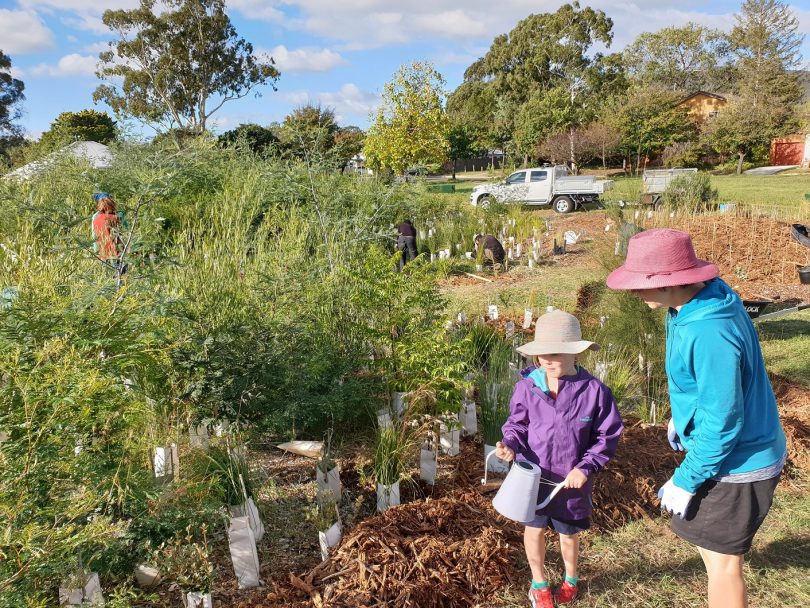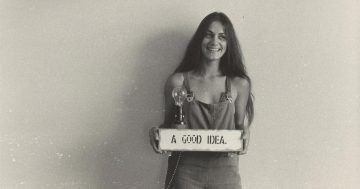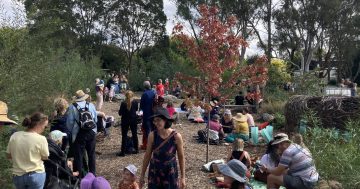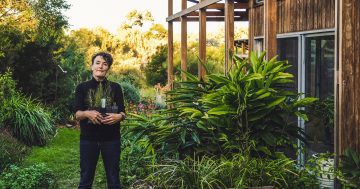
A local mum and daughter get stuck in to creating a microforest in Canberra’s north. Photo: Edwina Robinson.
As Canberra follows the trend of major cities around the world, high-density living is going to become the new reality.
But for many concerned locals, this should not mean hot, grey concrete as far as the eye can see.
The Climate Factory founder Edwina Robinson knows this only too well. She’s been behind the charge to plant cooling urban microforests in various north Canberra suburbs, and has encouraged other communities to do the same.
Edwina was concerned by CSIRO projections for Canberra which showed the suburbs most at risk of extreme heat. Unsurprisingly, these were newer suburbs on the city’s outskirts, in places such as Gungahlin, Molonglo Valley and West Belconnen.
“These new suburbs are often built to have larger houses on small blocks, taking away the possibility for shady elements such as big trees to be planted in the garden,” she says.
For some people living in apartments, cooling during summer can often be unaffordable, meaning they will have to escape to parks and green spaces for relief.
But not only is there scientific evidence to show that microforests can combat hotter and drier climates, Edwina also noticed that participants felt differently when the projects had been completed.
Lyneham resident Rob says he was “thrilled by the idea of coming past here as an old man, or for [his] kids to come past here as adults and see these little microforests that they created so many years before”.
Hope for the future is a common theme among people who are now leading the Watson Microforest project.
One on the project’s sponsors is Home.byHolly, and real estate agent Jenny McReynolds describes it as a wonderful way of bringing the community together.
“Having grown up in Watson and still being a local, it has been a real pleasure to see how the suburb has evolved,” she says.
“The generosity of the community, friendly locals and the overall vibe is really hard to beat.
“Most of the people leading the projects are mothers of young children, and I think they are doing it for their families as well as themselves to have that hope for the future.”
Maloneys Property principal Peter Maloney is wholly supportive of the need for Canberra to take a leaf from Europe’s book, especially as living is set to become increasingly dense in the coming years as land runs out.
“In big European cities, apartment dwellers generally have a well maintained and irrigated park nearby where they can walk their dogs in the morning,” he says.
“They have purposely set out beautiful parks and they look after them.”
While Peter is supportive of the community funded microforest movement, he’s also adamant the solution won’t come from any one stakeholder. Rather, it will require multiple levels of engagement, including developers, government and communities.
He says currently there is a distinct lack of planning and setting aside future areas for parks, as well as a lack of basic maintenance to the ones we already have.
“I can’t take my dogs to the local park – Griffith’s Blaxland Park – during summertime because it’s full of snakes,” says Peter.
“Collins Park in Forrest is going the same way. It’s not looked after and there’s no irrigation so it’s just becoming unusable.”
Peter is convinced it’s only going to become more important in the future to have dedicated spaces for parks.
“Right now, vacant blocks of land are being sold off for units, and car parks are being bulldozed, but I’m not seeing spaces for parks,” he says.
Given the ACT Government is making more money off rates for a whole complex of units or apartments, Peter is adamant some of these fees need to go to creating and maintaining green spaces.
“I think it’s fair to say that if a young family is able to purchase an apartment in Kingston for the same price as a small cottage with a garden in Banks, they would be more likely to choose the apartment if it is near a well maintained park,” he says.
If green spaces aren’t planned for, Peter is clear on one fact.
“They become harder to make – in fact, almost impossible – because you have to bulldoze something,” he says.















